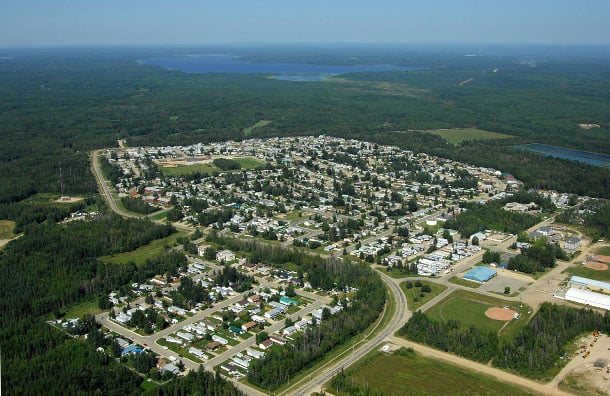Alberta’s “traffic light system” for preventing a destructive industry-caused earthquake flashed red again near Fox Creek, home to one of the largest quakes caused by fossil fuel frackers.
On March 22, a drilling company using hydraulic fracturing triggered an earthquake large enough to make the Alberta Energy Regulator, or AER, halt its operations.
Hydraulic fracturing, or fracking, which blasts apart rock with high pressure streams of water, sand and chemicals, has made Fox Creek one of the most seismically active areas in the province.
On Friday, Cygnet Energy, a small Calgary-based firm with assets in the Duvernay formation, reported a 4.1 magnitude tremor near one of their well sites, just 35 kilometres southwest of the community of Fox Creek.
The company suspended horizontal hydraulic fracturing as required by the AER’s traffic light system, which specifies that frackers must monitor seismic activity near their wells and stop fracking once they have caused a tremor greater than a magnitude 4 on the scale scientists use to measure the power of quakes.
Earthquakes measuring 4 are often felt by people in the area. In rare cases, they can cause damage to structures.
Gail Atkinson, Canada’s foremost expert on seismic hazards, has warned both B.C. and Alberta regulators that these traffic light systems have limited utility because they go into effect only after one or more tremors of a relatively high magnitude have occurred. She said the method won’t prevent major quakes.
“A traffic light system basically says, ‘Let’s do nothing and see if something bad happens.’ It’s akin to closing the barn doors after the horses have left,” Atkinson told The Tyee.
“A more effective strategy would be to proactively monitor low-level seismicity and discontinue operations promptly whenever the rates of small events [with magnitudes as low as 2] are higher than a nominal level. This would significantly reduce, but not completely eliminate, the possibility of larger follow-on events.”
Atkinson, who has studied industry-caused earthquakes in the Fox Creek area, has documented that a ramp-up in seismicity rates over time by hydraulic fracking greatly increases the hazard of producing larger tremors capable of damaging public infrastructure such as roads, dams and homes.
“More little earthquakes means more big earthquakes! And increased hazard,” explained Atkinson in a recent presentation. For every 100 seismic events measuring 3 caused by industry, these tremors will lead to approximately 10 tremors measuring 4 and about one hitting a level of 5.
“Because the response to fracking is inherently unpredictable, it should not be conducted in proximity to high-value infrastructure or populations,” Atkinson told The Tyee.
One of the largest earthquakes triggered by fracking occurred in 2016 just west of Fox Creek and was measured at 4.8 magnitude. That and other events sparked many scientific studies.
According to the AER’s “earthquake dashboard,” fracking caused a swarm of hundreds of earthquakes ranging from magnitudes of about 1 to 3 just 56 kilometres west of the town of Fox Creek this winter.
In February the Alberta Energy Regulator confirmed in an email to The Tyee the swarm including several tremors measuring around 3 that occurred between December and January.
“On Jan. 31, 2024, Kiwetinohk Energy reported a ML 3.3 seismic event. There were no reports of damage or injury at that time and Kiwetinohk engaged their mitigation protocols,” the AER told the Tyee.
The oil and gas industry has caused earthquakes throughout northeastern B.C. and Alberta by rapidly draining reservoirs, by injecting wastewater deep into the ground, by water flooding for enhanced oil recovery, by injecting steam into bitumen deposits and by hydraulic fracking. Many of these tremors have damaged wellbores.
Researchers have pointed out that deep carbon storage and geothermal projects can also trigger earthquakes.
In fact Alberta researchers have recommended a tougher traffic light system for geothermal projects than the one currently regulating fracking. It would trigger a major evaluation of operations when 1.5 magnitudes occur and shut down the operation at 3.5 magnitude with the goal of keeping all tremors at low magnitude.
Obsidian Energy, a heavy oil producer, caused the largest industry-made earthquake to date, a 5.6 magnitude tremor that rocked Peace River country two years ago. The AER’s traffic light system failed to prevent the temblor, which occurred after its injection well caused waves of smaller quakes over a four-month period between 2022 and 2023.
The Woodland Cree First Nation, which is located near the injection site, says Obsidian Energy has still not addressed their concerns about its earthquake triggering operations and is seeking a new economic agreement.
In a recent news release Obsidian said the disagreement wasn’t about earthquakes but money.
“While WCFN senior leadership rejected our most recently proposed economic relationship agreement, we are open to meeting with WCFN senior leadership to further discuss the potential for an agreement,” the company said.
The AER initially suggested that the record-setting quakes that occurred in Peace River were all natural.
The regulator didn’t change its tune until a Stanford University study conclusively proved them wrong.
Allan Chapman, a former senior geologist with the BC Energy Regulator (formerly the Oil and Gas Commission) has repeatedly warned authorities that there are no upper limits on the magnitudes of tremors industry can cause and that regulators remain in a state of denial about the growing hazards.
In a recent scientific paper Chapman called for frack-free zones, a more stringent traffic light system and legislation that requires companies to make their own seismic monitoring public as a condition of operation.
Currently, much seismic information in the oil patch is considered proprietary and may not be made public for a year after a quake. ![]()
Read more: Energy, Alberta, Environment

















Tyee Commenting Guidelines
Comments that violate guidelines risk being deleted, and violations may result in a temporary or permanent user ban. Maintain the spirit of good conversation to stay in the discussion and be patient with moderators. Comments are reviewed regularly but not in real time.
Do:
Do not: